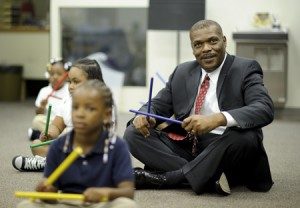Shout Out to Detroit
CompetencyWorks Blog
 I just got back from two days of school visits in Detroit — and I just have to give a SHOUT OUT to all the innovators that are creating student-centered, mastery-based schools that fully integrate blended learning into their operations. And they are getting results!
I just got back from two days of school visits in Detroit — and I just have to give a SHOUT OUT to all the innovators that are creating student-centered, mastery-based schools that fully integrate blended learning into their operations. And they are getting results!
Seriously, Detroit is a hotbed of competency education.
The Education Achievement Authority, designed to help turn around low performing schools, is at the heart of much of this work with a vision for student-centered learning. The EAA leadership of Dr. John Covington and Mary Esselman, along with the hundreds of innovators in the EAA schools, share a powerful vision and the courage to be wonderfully creative. They also have that no-excuse mentality that comes from an incredible love for and commitment to children. Their work over the past two years hasn’t just been about implementing dynamic classrooms using the information management system Buzz, it’s been about cleaning out tons of junk out of schools (8 tons from one school), door knocking to create a community of volunteers, establishing hundreds of partnerships across the city, and creating a culture of safety and respect using restorative justice.
I visited 3 schools in the EAA that were in the 2nd year of implementation and they are already seeing the 2nd cycle of innovation as teachers explore ways to take advantage of a blended, mastery-based environment. Here are just a few highlights with lots more to come:
Challenge #1: Why do students spend 50 minutes on each subject regardless of whether they are ahead in English or behind in math?
Solution: Southeastern Technical High School teachers created PACE for students ready to be independent learners so that they can focus their time in school on the subjects that they need the most help and advance as much as they want. They created a facility with a large open room that feels just like a college library with lots of small study rooms. Teachers have offices but no classrooms. Buzz allows teachers to guide students, providing direction on the content, practice, applications and assessments for each learning target and unit. There is a weekly schedule so students know about college visits and when lectures are happening for their classes — but there is a lot of “free” or unscheduled time for students use to work on their coursework. Students schedule with teachers whenever they need help.
Challenge #2: How can we improve the capacity of students to embrace new concepts? As students move through centers or rotations in a classroom (teacher-led instruction, small group, blended), they have to shift their orientation to learning. This may be a lot to ask for young children, especially children who have never spent much time in pre-school.
Solution: Teachers at Phoenix Multicultural Academy created a Learning Village for 1st and 2nd graders — the majority are English Language Learners. They blended the grades as so many children were entering below grade or in EAA-speak most were at Level 1 or below. Using their classrooms to create environments more conducive to learning, they separated the rotations so one classroom was designed for the delivery of new concepts. Not a desk is in sight in the teacher-led instruction classroom — just a sense of calm, openness, and room to move. Students sat on the floor in front of the teacher while she introduced letters of the alphabet with a sing-a-long video. A young boy was perched on a chair assisting the teacher by managing the computer to start the video whenever needed. In the next classroom, the teacher was working with a small group practicing understanding the sounds of the alphabet and writing down letters while another group were huddled around laptops working on online content.
As always, in a high quality student-centered classroom, it’s amazing to see the degree that students are on task. It’s all about time, right? Time on task.
Next week, I’ll have a lot more on the Detroit mastery-based schools.